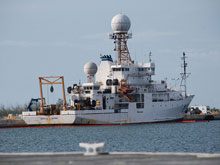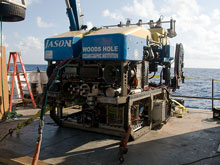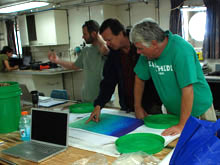
The NOAA ship Ronald H. Brown, in port, Key West, Florida. Click image for larger view and image credit.
Assembling the Research Team
August 20, 2009
After months of preparation, we are now underway on the NOAA ship Ronald H. Brown, leaving our pier in Key West, Florida. It is Wednesday afternoon, August 19. The team convened from all over the United States — from Philadelphia, Pennsylvania, to Seattle, Washington, Corpus Christi, Texas, and many points in between. One biologist just finished sailing on another research cruise in the north Atlantic Ocean two days before her departure with this cruise! A wide range of professionals comprise our research team, including biologists, ecologists, geneticists, graduate students, data managers, educators, a video photographer, and the pilots, engineers, and mechanics for the remotely operated vehicle (ROV) Jason.
Jason: A Key Team Member
The ROV Jason is a very important member of the research team. Traveling to the Gulf of Mexico from a previous cruise in the Pacific Ocean, the ROV and all of its associated equipment transited in eight freight containers on several trucks. Jason's team — a group of 10 pilots, engineers, and mechanics — has worked long hours for the past four days, reassembling the vehicle and the electronic equipment that controls it. The ROV is an amazing assemblage of instruments and electronics securely attached to a steel frame to create a sophisticated piece of scientific equipment capable of exploring Earth’s oceans down to 6,500 meters ((21,325 foot) depth. On our cruise, Jason will be working in waters from 350 to 2,550 m (1,148 to 8,366 ft) depth. The equipment will be operating in near-freezing waters — as low as 4°C! (39ºF) under high pressures, for days at a time when necessary.
In addition to reassembling the vehicle, the Jason team has been reconnecting the bank of computers on the ship that control seafloor operations through a fiber-optic cable. From the outside, the structure housing the computers looks like an ordinary freight shipping container. On the inside, the space is filled with computers, numerous monitors, recording equipment, navigation equipment, and high-tech joystick controls to maneuver Jason in any direction. Running a Jason dive requires a minimum of six people, including the pilot, engineer, navigator, and scientists to direct tasks and record video and data. This control center, affectionately called “The Van,” will soon become a hub of excitement as images of the seafloor and underwater life, some never before seen, start appearing on the monitors.
Jason is designed to perform precise underwater operations thousands of kilometers beneath the ship. To protect these operations from wave action at the surface tugging on the ROV’s tether, a second vehicle named Medea is positioned in between Jason and the ship. When the ship rolls in the waves, the cable tugs on Medea but not on Jason. Medea is equipped with cameras, so the pilot can monitor Jason's movements from different vantage points.
Diving to a Site for the First Time
Today, the main science lab on the Ron Brown is bustling with activity as the science team prepares for the first Jason dive, scheduled for just before sunset. No one has seen our first dive site before. Join us in the exploration by checking the daily log as we search for new coral communities in the Gulf of Mexico!





























